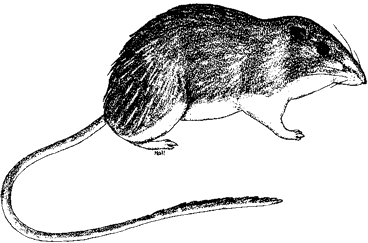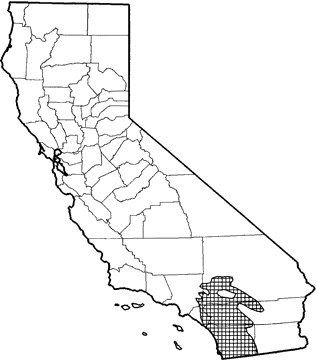
San Diego Pocket Mouse
Distribution, Abundance, and Seasonality
Common resident of sandy herbaceous areas, usually in association with rocks or course gravel (Grinnell 1933, Miller and Stebbins 1964) in southwestern California. Occurs mainly in arid coastal and desert border areas in San Diego Co., in Riverside Co. southwest of Palm Springs, in San Bernardino Co. from Cactus Flat in the San Bernardino Mts. to Oro Grande and east to Twenty-nine Palms. Elevational range from sea level to 1350 m (4500 ft) (Santa Rosa Mts., Riverside Co.) and 1800 m (6000 ft) (Cactus Flat, north slope San Bernardino Mts.). Habitats of the San Diego pocket mouse include coastal scrub, chamise-redshank chaparral, mixed chaparral, sagebrush, desert wash, desert scrub, desert succulent shrub, pinyon-juniper, and annual grassland.

Range Map
Specific Habitat Requirements
Feeding: Forages on seeds of forbs, grasses, and shrubs. Meserve (1976b) reported a low to moderate preference for forb and shrub seeds, and a high preference for grass seeds. Seeds are transported in cheek pouches and stored in and around the burrow. Some insects are eaten.
Cover: Miller and Stebbins (1964) reported highest densities in rocky/gravelly areas with a yucca overstory, and in desert scrub near or in the pine-juniper belt. Burrows are excavated in gravelly or sandy soil and used for daytime resting, predator escape, and care of young.
Reproduction: No data found.
Water: Water is obtained metabolically from leafy vegetation, seeds, and probably also from insects.
Pattern: Moderate canopy coverage of arid shrubland or pinyon-juniper habitats on or near rocky slopes and sandy areas.
Species Life History
Activity Patterns: Nocturnal. Active year-round although surface activity reduced during cold spells.
Seasonal Movements / Migration: None reported.
Home Range: Home range in southern California (Claremont) varied from 0.19 to 0.45 ha (0.5 to 1.12 ac), averaging 0.36 ha (0.9 ac) for males and 0.25 ha (0.62 ac) for females (MacMillen 1964).
Territory: Probably same size as home range.
Reproduction: Breeding occurs chiefly from March to May. An average of 4 young comprise a litter. Gestation 24-26 days (Hayden et al. 1966).
Niche: Nocturnal granivore in arid coastal and desert scrub areas, in association with rocky, gravelly, or sandy ground. Predators include foxes, coyotes, badgers, owls, and snakes.
Sources & References
California Department of Fish and Game, 1999.
California's Wildlife, Sacramento, CA.
Written by: P. Brylski, reviewed by: H. Shellhammer, edited by: R. Duke
Grinnell, J. 1933. Review of the recent mammal fauna of California. Univ. Calif. Publ. Zool. 40:71-234. Hayden, P., J. J. Gambino, and R. G. Lindberg. 1966. Laboratory breeding of the little pocket mouse, Perognathus longimembris. J. Mammal. 47:412-423. MacMillen, R. E. 1964. Population ecology, water relations and social behavior of a southern California semidesert rodent fauna. Univ. Calif. Publ. Zool. 71:1-59. Meserve, P. L. 1976b. Food relationships of a rodent fauna in a California coastal sage scrub community. J. Mammal. 57:300-319. Miller, A. H., and R. C. Stebbins. 1964. The lives of desert animals in Joshua Tree National Monument. Univ. California Press, Berkeley. 452pp.
California Animal Facts | California's Wildlife